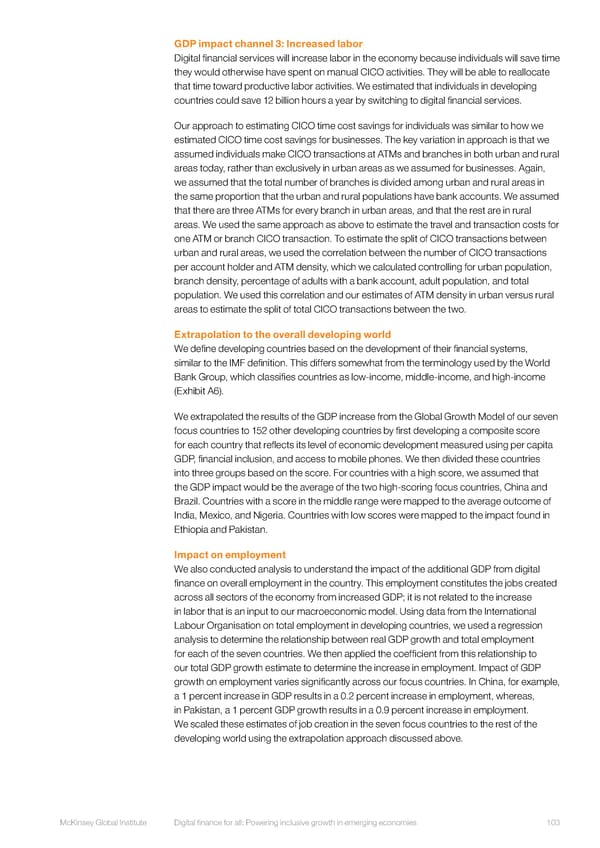GDP impact channel 3: Increased labor Digital financial services will increase labor in the economy because individuals will save time they would otherwise have spent on manual CICO activities. They will be able to reallocate that time toward productive labor activities. We estimated that individuals in developing countries could save 12 billion hours a year by switching to digital financial services. Our approach to estimating CICO time cost savings for individuals was similar to how we estimated CICO time cost savings for businesses. The key variation in approach is that we assumed individuals make CICO transactions at ATMs and branches in both urban and rural areas today, rather than exclusively in urban areas as we assumed for businesses. Again, we assumed that the total number of branches is divided among urban and rural areas in the same proportion that the urban and rural populations have bank accounts. We assumed that there are three ATMs for every branch in urban areas, and that the rest are in rural areas. We used the same approach as above to estimate the travel and transaction costs for one ATM or branch CICO transaction. To estimate the split of CICO transactions between urban and rural areas, we used the correlation between the number of CICO transactions per account holder and ATM density, which we calculated controlling for urban population, branch density, percentage of adults with a bank account, adult population, and total population. We used this correlation and our estimates of ATM density in urban versus rural areas to estimate the split of total CICO transactions between the two. Extrapolation to the overall developing world We define developing countries based on the development of their financial systems, similar to the IMF definition. This differs somewhat from the terminology used by the World Bank Group, which classifies countries as low-income, middle-income, and high-income (Exhibit A6). We extrapolated the results of the GDP increase from the Global Growth Model of our seven focus countries to 152 other developing countries by first developing a composite score for each country that reflects its level of economic development measured using per capita GDP, financial inclusion, and access to mobile phones. We then divided these countries into three groups based on the score. For countries with a high score, we assumed that the GDP impact would be the average of the two high-scoring focus countries, China and Brazil. Countries with a score in the middle range were mapped to the average outcome of India, Mexico, and Nigeria. Countries with low scores were mapped to the impact found in Ethiopia and Pakistan. Impact on employment We also conducted analysis to understand the impact of the additional GDP from digital finance on overall employment in the country. This employment constitutes the jobs created across all sectors of the economy from increased GDP; it is not related to the increase in labor that is an input to our macroeconomic model. Using data from the International Labour Organisation on total employment in developing countries, we used a regression analysis to determine the relationship between real GDP growth and total employment for each of the seven countries. We then applied the coefficient from this relationship to our total GDP growth estimate to determine the increase in employment. Impact of GDP growth on employment varies significantly across our focus countries. In China, for example, a 1 percent increase in GDP results in a 0.2 percent increase in employment, whereas, in Pakistan, a 1 percent GDP growth results in a 0.9 percent increase in employment. We scaled these estimates of job creation in the seven focus countries to the rest of the developing world using the extrapolation approach discussed above. McKinsey Global Institute Digital finance for all: Powering inclusive growth in emerging economies 103
 DIGITAL FINANCE FOR ALL Page 120 Page 122
DIGITAL FINANCE FOR ALL Page 120 Page 122